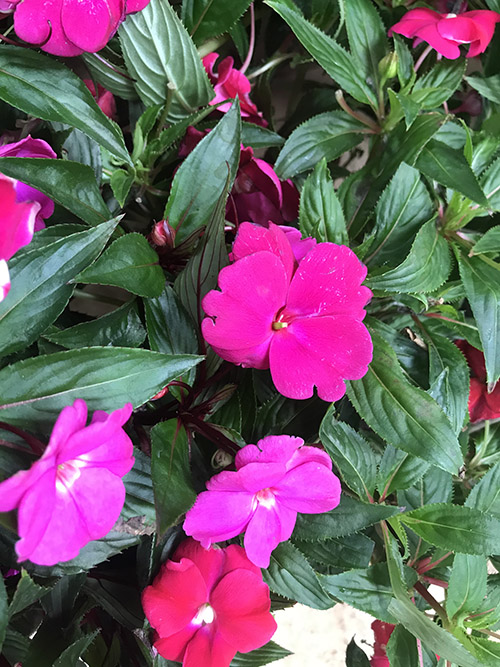Let It Grow
By Tammy Thornton
Normally, when one sets out to plan a new garden, they choose the sunniest spot in their yard and search for big beautiful flowers to fill it. But what do you do when the sun doesn’t shine on you—or your garden? Shady gardens can flourish as well, if you choose the right plants for the space.
Observe different parts of your yard throughout the day. You may consider a space to be shady, only to realize it receives quite a bit of sun in the morning or afternoon. Or, you may have planted bold flowers in your sunny garden, but they never really bloom again. When you study the sun patterns at various stages of the day, it’s possible you’ll discover that your flower spent less time sun-bathing than you thought. Get to know your garden before you buy flowers to fill it, and read plant labels as you shop. If a plant tag indicates that it needs “full-sun”, that means it requires at least six hours of direct sunlight to thrive. Chances are, at least a portion of your garden falls into the shade or part-shade category.

Once you’ve done your sun-study homework, you’ll know what parts of the garden need plants that prefer shade or part-shade. That doesn’t mean you must be resigned to a boring and dreary space, devoid of flowers. Instead, it will open the door to a range of plants and flowers that would never survive hours of harsh sun. A hanging basket of fuchsia will make a stunning statement with its colorful and exotic flowers. And as a bonus, it’s a hummingbird magnet. Fuschia should be placed in a part-shade location, since full-sun may cause it to stop flowering or wilt. Choose a spot with morning sun or dappled sun coming through the trees throughout the day for this tropical beauty. Bleeding heart (dicentra) is another plant that has strikingly unique flowers. This elegant plant with its arching stems will bloom in early spring and since it’s a perennial, will come back year after year, under the right conditions. My go-to flowers for a partly shady garden are impatiens. You can find flats of impatiens available in many different colors to brighten a dark spot in the garden. They are annuals in our area, so you must wait until all threat of frost is gone in the spring. But once you get them in the ground, they will flourish and spread, filling a space beautifully. You can also add colorful flowers to your shade garden by using their cousins, New Guinea impatiens, which seem to have a more exotic look. Other colorful flowers that make good candidates for shade gardens are foxgloves, brunnera, tuberous begonia, and lobelia, to name a few.
A great way to brighten a shady, dark space in your garden is to fill it with white flowers. When you are strolling through the garden on an evening walk, white flowers will seem to light your way along the path. Taller white flowers will appear to be suspended in air since the stems and leaves will disappear in the dark, giving your garden a mysterious look. Though white flowers will work best for this effect, yellow and light pink flowers will also show well in a dark corner of the garden.
Using plants with variegated leaves is another way to brighten a dark space. Look for Solomon’s seal with variegated leaves. Its tall arching stems and white bell-flowers will quickly spread and fill a shady spot or woodland garden. For a fast-growing ground cover, plant variegated liriope, also known as lilyturf. Though I have different types of liriope in my garden, my favorite has yellow variegated leaves that are unique looking. Though it is mainly grown for its grasslike foliage, later in the season spikes of white or lavender colored flowers will shoot up and bloom, reminding you why you planted this aggressive grower. For a shade-loving ground cover with an amazing scent, choose lily of the valley. Its fragrance will pleasantly waft through your garden.
When it comes to shade gardens, you can add a lot of interest by focusing on foliage. Hostas have so many varieties (including variegated types), that you could create an entire shade garden with hostas alone. They come in shades of yellow, chartreuse, white, and blue. There are mini hostas and gigantic ones, some having heart-shaped leaves, others lance-shaped. Plant in groupings of the same types alongside those with contrasting foliage. Later in the season, hostas will send up stems with tubular flowers that will attract hummingbirds. Another shade-plant valued for its foliage is heuchera, or coral bells. Heuchera has a seemingly limitless variety of plants with eye-catching foliage. From lime-green to deep purple or burgundy and everything in between, coral bells have tall thin stems topped with tiny bell flowers that will also attract hummingbirds. Of course, when using foliage-focused plants in the garden, you can’t overlook coleus. Though this plant is an annual, it’s worth adding to your shade garden each year. It can also be easily propagated from cuttings and brought indoors for the winter. Shades of hot pink, burgundy, lime-green, and yellow leaves compete with any flower when it comes to colorfulness. Coleus also develops its own flowers, but they are insignificant compared to the foliage.
As you can see, shady gardens can be full of excitement with colorful foliage and flowers, or bring tranquility with calming green and white along pathways. I dream about a picture I saw of a woodland filled with ferns and bluebells. You can imagine a hush and sense of peacefulness that you would feel walking through that garden. After spending a hot day in the sun, entering the shade garden brings a much needed cool break from the heat as you reflect on your day. Be creative with foliage and add interest to a dark corner of the garden. You’ll soon find yourself craving to relax in a garden made in the shade.
Tammy Thornton is a mom of four, a substitute teacher, and a Sunday school teacher. She is passionate about gardening and cooking, and loves the beach.








